
Part 2. The Species (In order of appearance):
BEIPIAOSAURUS inexpectatus (Xu, Tang & Wang, 1999)
ALXASAURUS elestaiensis (D. A. Russel & Dong, 1995)
NEIMONGOSAURUS yangi (Zhang, Xu, Sereno, Kuang & Tang, 2001)
"NANSHIUNGOSAURUS" bohlini (Dong & You 1997)
NOTHRONYCHUS mckinleyi (Kirkland & Wolfe vide Stanley, 2001)
SEGNOSAURUS galbinensis (Perle, 1979)
THERIZINOSAURUS cheloniformis (Maleev, 1954)
ENIGMOSAURUS mongoliensis (Barsbold & Perle, 1983)
ERLIKOSAURUS andrewsi (Perle vide Barsbold & Perle, 1980)
NANSHIUNGOSAURUS brevispinus (Dong, 1979)
"CHILANTAISAURUS" zheziangensis (Dong, 1979)
ESHANOSAURUS deguchiianus (Xu, Zhao & Clark, 2001)
Part 3. Further Notes:
Their pelvis was perfectly shaped for sitting on, the same way ground sloths and calicotheres sat, As shown in the skeletal restoration, the Therizinosaurs, not only sat, but
There has been speculations within both fish eating, and termite eating habits for these animals,
If we look at the cladogram history of this animals, it started in 1979, with Segnosaurus.
Basic Readings
Currie, J. P., Padia, K., (1997). Encyclopedoa of Dinosaurs, pp 869.
Fastovsky, D. E., Weishampel, D. B., (1996). The Evolution and Extinction
Norman, D. B., (1985). The Illustrated Encyclopedia of Dinosaurs, pp 208.
Paul, G. S., (1988). Predatory Dinosaurs of the World, pp 464.
Copyright 2001 © Øyvind M. Padron, all rights reserved
Part 1. Cladogram:
THERIZINOSAURIA (a.k.a. SEGNOSAURIA)
|-Beipiaosaurus
|
|-Therizinosauroidea ("true" therizinosaurs)
|-Alxasauridae
| |-Alxasaurus
|
|-?Neimongosauridae (unofficial clade)
| |-Neimongosaurus
|
|-Therizinosauridae (ischium in direct contact with pubis)
|-?"Nanshiungosaurus"
|-Nothronychus
|-Segnosaurus
|-?Therizinosaurus
|
|-UNNAMED CLADE (ischium fused to pubis)
| |-Enigmosaurus
| |-?Erlikosaurus* (added by speculation only)
|
|-Nanshiungosaurus (spoonshaped ischium & fused cervical vertebrae)
*=no pelvis known for this species
however, it may be the same as
Enigmosaurus
Excluded species:
"Chilantaisaurus" zheziangensis
Eshanosaurus deguchiianus

Time: Barremian, Gallic, Early Cretaceous, 120 m.y.a.
Place: China
Size: ca 2m.
Remains: Cranial fragments, mandible, 3 cervical vertebrae, 4 dorsal
vertebrae, 1 caudal vertebra, scapula & scapulacoracoid, complete
forelimb, complete pelvis with hindlimb.
Notes: This therizinosaur was very basic, and has a lot of features
with other coelurosaurs, especially oviraptorosaurids (pelvis).
Another special feature about this species, is that it was found
with feather impresions, some as long as 7 cm. on it's ulna.
Illustration:
Time: Albian, Gallic, Early Cretaceous, 112 m.y.a.
Place: Mongolia
Size: 3,5-4m.
Remains: IVPP 88402, 88301, 88510 & 88501.
Allmost complete skeleton, only missing skull (except for mandible)
elements of scapula and scapulacoracoid, ?furcula, breastbone, part of ilium, pubis
root of ischium, and tail tip.
Notes: This species was probably the most primitive of the raised-up
therizinosaurs, as the back vertebrae are designed to lift an animal in
allmost upright position. In my illustration below, it is leaning foreward
in a running pose. The tail and legs were short, and designed for little
movement. This animal was still most of the time. The ribcage is broad, and
allready here, it indicates herbivorous life-style. The ilium shows a
preacetabular process (the part of the ilium anterior to the socket) that
is slightly turning downwards and to the sides.
Illustration:
Time: Late Cretaceous
Place: China
Size: ca 2m.
Remains: (to be updated)
Notes: This species is a bit difficult to classify, as it's got more
cervical vertebrae than both Alxasaurus and Nanshoungosaurus.
At the same time, it's pelvis is fairly fragmental, and cannot be used to
classify much. It is allmost entirely the vertebral structures, the lenght
of the tail, the mandibular fragment and the general structure of the animal
that helps put a diagnosis on this species.
Illustration: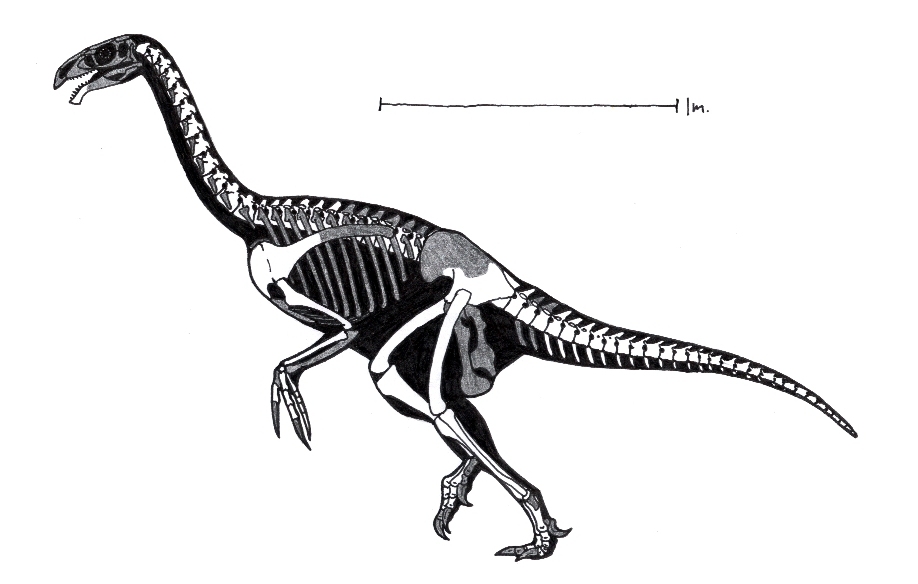
Time: Barremian, Gallic, Early Cretaceous, 120 m.y.a.
Place: China
Size: 4m.
Remains: Vertebrae, ribs.
Notes: This species differ from Nanshiungosaurus
time, and by having cervical ribs.
Illustration: None
Time: Turonian, Gallic, Late Cretaceous, 89 m.y.a.
Place: New Mexico, USA.
Size: 4,5-6m.
Remains: MSM P21026. 7 cervical vertebrae, scapula, arm, incolplete hand
claws, ribs, ischium, tibia, fibula, metatarsals, phalanges, 1 caudal vertebra.
Notes: This species has neck vertebrae ver similar to those of Alxasaurus
and a ischium very similar to Segnosaurus. Since we got no neck vertebrae from
Segnosaurus it's difficult to decide where to classify it. But personally,
I think that the ischium insimilarities to Alxasaurus overweights the
vertebrae similatities, and put Nothronychus in the same group as Segnosaurus.
Illustration: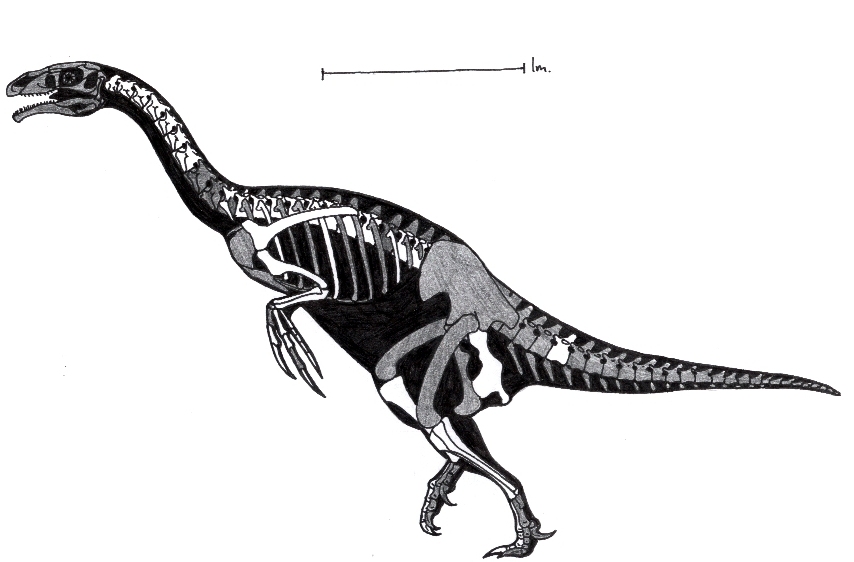
Time: Cenomanian - Turonian, Gallic, Late Cretaceous, 93-89 m.y.a.
Place: Mongolia
Size: 4-9m.
Remains: GI SPS 100/80, 100/81, 100/82. Mandible, pelvis girdle, spine
fragments, metatarsals, phalanges, partial scapula, coracoid, humerus, tibia,
fibula, complete pelvis.
Notes: The few remains of this species indicate low, broad pes and a wide
pelvis, the same features as Alxasaurus, only more prominent. The pubis
is clearly backwards pointing, and the ischium is in direct contact with the pubis.
The lower jaw has a strong downwards bend in it, and got tall peg-like teeth.
Here the preacetabular process has got a strong downwards turn on it, and seen
from above, they bend right out to the sides.
Illustration: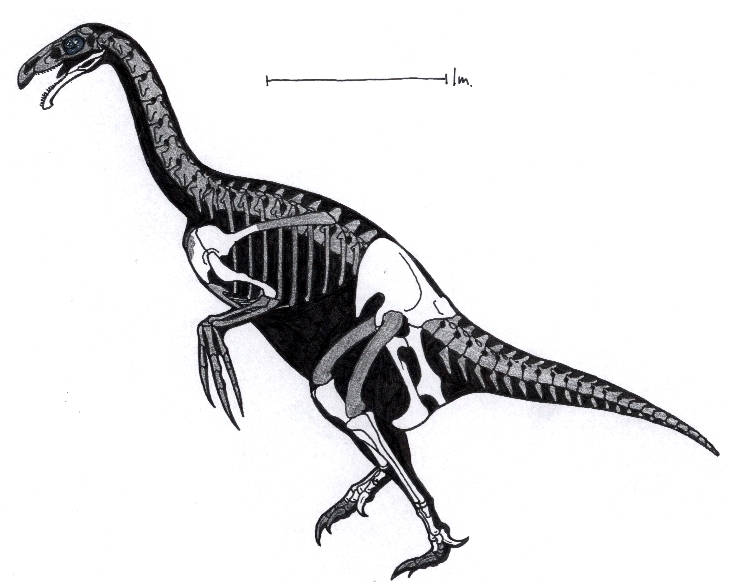
Time: Campanian, Senonian, Late Cretaceous, 71 m.y.a.
Place: Mongolia, Kazakhstan, Transbaykalia
Size: 8-11m.
Remains: Partian forelimb, foot, vertebrae, hindlimb, claws, tooth.
Notes: This species forelimbs are the only ones that are as good known
as in Alxasaurus. They present strong arms, with long fingers, and blade-
like claws. More than this is difficult to state about this species.
Illustration: see Nanshiungosaurus brevispinus
Time: Cenomanian - Turonian, Gallic, Late Cretaceous, 93-89 m.y.a.
Place: Mongolia
Size: ca 6m.
Remains: Partial ilium, fused pubis/ischium.
Notes: May be the pelvis of Erlikosaurus.
The Pubic boot is shaped much sharper than the one of Segnosaurus,
and so is the ischium, which is totally fused to the pubis, making it
one single pelvic bone.
Illustration: see Erlikosaurus andrewsi
Time: Cenomanian - Turonian, Gallic, Late Cretaceous, 93-89 m.y.a.
Place: Mongolia
Size: ca 6m.
Remains: Complete skull, allmost complete foot, vertebrae,
humerus and partian hindlimb.
Notes: This species is the only one known with a complete skull
The lower jaw is not as strongly curved as in Segnosaurus but still
shows a slight curve, and the same type of teeth. The upper jaw poses a
toother maxilla and a toothless premaxilla, which could have been a beak.
The foot elements are very similar to Segnosaurus.
Illustration:
Time: Campanian, Senonian, Late Cretaceous, 71 m.y.a.
Place: China
Size: 4m.
Remains: Complete cervical/dorsal vertebral column, incomplete pelvis.
Notes: This is the only therizinosaur with cervical ribs shrinked to small bumps
and fused to the cervical vertebrae. The neck was robust, and so was the dorsal column.
The pubis is only known by a little bony knob, but was probably similar to the one of
Segnosaurus, while the ischium was much broader, and spoonshaped. The ilium
is much taller as well. The downward turning of the preacetabular process in this
species goes to the extreme, but they are about the same as in Segnosaurus
when seen from above.
Illustration: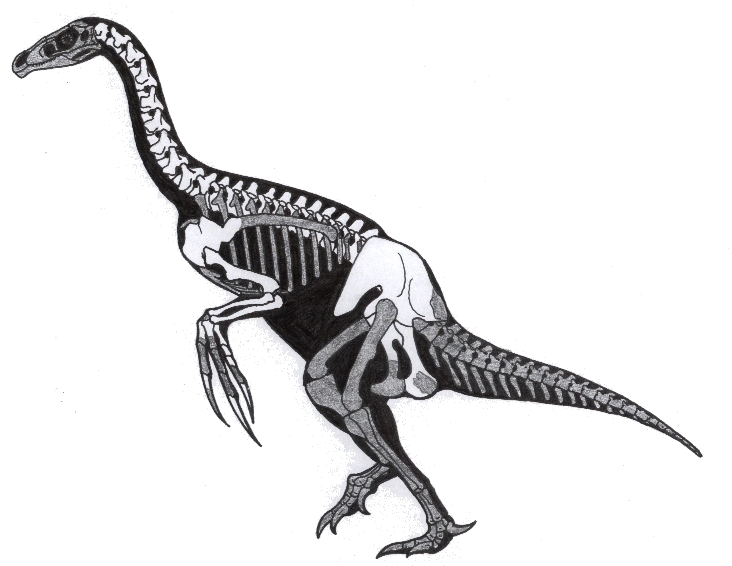
Time: Late Cretaceous
Place: Mongolia
Size: unknown
Remains: Claws
Notes: This species has been classified under "Segnosaurus" zheziangensis
and might really be any Mongolian therizinosaur that fits it's size.
Illustration: None
Time: Hettangian, Lias, Early Jurassic, 200 m.y.a.
Place: China
Size: ca 1m. (if therizinosaur) or 1,5-2m (if prosauropod)
Remains: Mandible
Notes: Has been thought to be a Therizinosaur due to the mandible shape
but the time it lived, points to that it may really have been a Prosauropod
of some kind. There's still debated going on about this.
Illustration: None

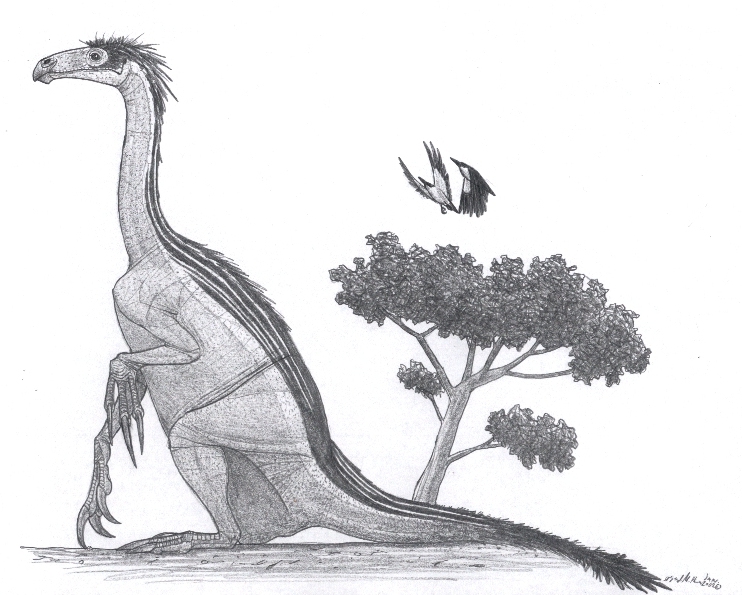
The most probable therizinosaurid posture; sitting, while eating plants
These creatures were not hunters, but most probably the only completely herbivorous theropods known.
when feeding from trees. The long arms with their long, curved claws, seem to have been a nice tool
to get vegetables directed towards the mough, and allso as great defence against predators, as
running was not an option.
Another link to the sitting way of life, lies in the dorsal vertebrae, as they are tall, and built for
keeping a big animal vertically - most probable sitting. The tail is allso very short, and would
work poorly for balancing the animal, if walking in horizontal positure; another indication of a
vertical life style.
walked and maybe even ran (what they could) in vertical body positure.
but their teeth were not good fit for fish eating, and termites would be a ridicolous diet to feed
a gigantic Therizinosaurus!
It was a mystery, and it was uncertain wether they were dealing with one or more animals, but when
the species Erlikosaurus was discovered, they could compare the strange, flat feet, and the
weird, curved, lower jaw. The discovery of Enigmosaurus was the final detail that they needed
to discover that they were dealing with a completely new group
of dinosaurs.
Now, that fact didn't help them much. What were this creatures?
Theropods? Sauropods? Ornithischians?
Nanshiungosaurus was for a long time classified as a strange Sauropod, while Therizinosaurus
remained classified as a huge, enigmatic theropod within Deinonychosauria, or it's own group
for a very long time.
It wasn't untill Alxasaurus was found that Therizinosauria was attached, not only to theropoda,
but to coelurosauria. Nanshiungosaurus and Therizinosaurus was allso recognized as
Therizinosaurs (the group was originally called Segnosauria), due to similarities in the vertebrae
and forelimbs. "Chilantaisaurus" zheziangensis was included due to it's huge claws.
Later, with the discovery of Beipiaosaurus, their place as Oviraptorosaurid relatives,
has been emphasized.
The discovery of Nothronychus given proof of Therizinosaurs being spread outside
Asia, and the new species Eshanosaurus may even indicate Therizinosaurs, and even the
entire Coelurosauria, to have existed as early as Early Jurassic. But this species is most
likely to be a primitive Sauropodomorph of some kind.
Academic Press, New York.
of the Dinosaurs, pp 460. Cambridge Univ press, Cambridke, UK.
Salamander Books LTD, London, UK.
Simon & Schuster, New York.
INDEX | MESSAGES | A-Z | CLADOGRAM
SPECIAL | GUESTBOOK | LINKS